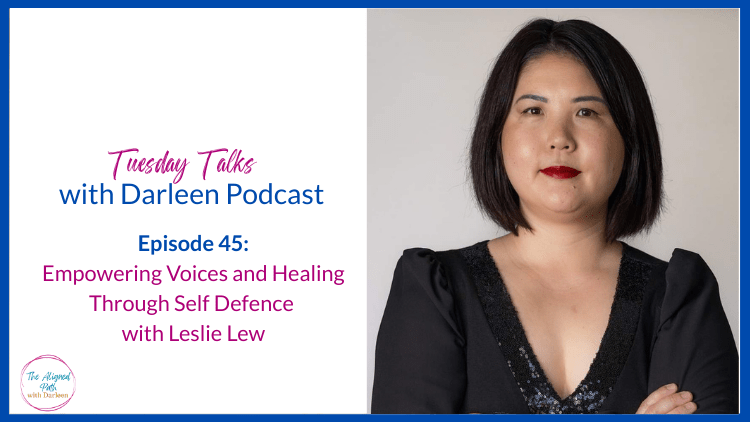Power doesn’t always come from strength. It comes from clarity. From knowing what’s true. From holding space for your own voice even when the world tells you to be quiet. For those healing from trauma or navigating mental health, power often begins with awareness, and then, with practice, becomes embodied.
Reclaiming that power is not about becoming someone else. It’s about becoming the version of yourself who knows she is worth protecting. It’s about learning to say no without apology. To name a boundary without over-explaining. And to take up space with presence, not just words.
This kind of power lives in the nervous system. And when a self-defense practice is trauma-informed, it’s not just about physical technique, it’s about helping women feel safe enough to take up space again.

EPISODE 45: Listen using the player below, or click the links to your fave platform to subscribe and listen over there:
Redefining Self-Defense
Traditional models of self-defense often focus on threat response, pepper spray, keys in hand, forceful moves. But that approach doesn’t always serve women who are survivors, neurodivergent, or simply not comfortable in high-adrenaline environments. Trauma-informed self-defense brings something different. It integrates mind, body, and voice.
This approach understands that physical movements are not accessible to everyone in the same way. It recognises that yelling or striking can be triggering. And it centres the idea that self-defense starts long before a physical encounter. It begins with inner talk. With how boundaries are vocalised. With the stories a woman tells herself about what she deserves.
Reframing self-defense in this way opens the door for healing. It turns survival tools into empowerment practices. And it supports women in every situation, not just in the street, but in the workplace, in relationships, and in everyday moments that demand self-advocacy.
Navigating Non-Physical Threats
Physical safety is only one part of the equation. For many women, the most consistent threats aren’t physical, they’re energetic. They come through workplace microaggressions, family dynamics, boundary violations, and gaslighting. And these require just as much attention, clarity, and skill to navigate.
- Many women feel the most unsafe in professional or family settings, where clear advocacy is met with resistance
- Speaking up can be misread as aggression, especially in environments that don’t value emotional truth
- Setting a boundary with clarity, without apology or explanation, is a powerful act of self-protection
- Self-talk often becomes the first attacker; reframing inner language is critical to reclaiming voice
- Safety isn’t always about exit plans or physical moves, it’s about feeling emotionally and energetically resourced to respond
Understanding the patterns behind silence, why someone hesitates to speak, advocate, or draw a line, allows space for that pattern to shift. Not forcefully, but with care.
Cultural Conditioning and Visibility
Cultural messages play a powerful role in how women navigate visibility and voice. Many are taught to be quiet, compliant, and non-disruptive. To avoid rocking the boat. To succeed silently. This conditioning doesn’t disappear when a business is launched or a leadership role is stepped into, it often intensifies.
Reclaiming visibility means confronting those inherited beliefs. It means recognising how deeply the fear of shame or disapproval runs. And it means choosing to show up anyway, not to prove something, but to honour something deeper.
This work often requires unlearning. Unlearning the need to explain everything. Unlearning the fear of upsetting others. Unlearning the belief that taking up space is unsafe. And in its place, learning a new way to be in the body. A new way to speak. A new way to be seen.
Embodying Boundaries and Energetic Authority
Boundaries don’t need to be harsh. They don’t require long explanations. A single clear statement, held with energetic conviction, can be more effective than a dozen justifications. When voice, body, and mind align, the message becomes unmissable.
Energetic boundaries often come before words. If the body is slumped or collapsed, the voice can be lost. But when the body stands in truth, the voice gains strength. And when the mind is clear, boundaries are easier to hold.
This work is about more than technique. It’s about coherence. About choosing alignment over performance. And about remembering that safety is not just something you create for yourself, it’s something you model for others.
Final Reflections
Power isn’t loud. It’s clear. It’s intentional. It’s the quiet, steady decision to stand in truth, hold boundaries, and speak with conviction. It’s the practice of integrating mind, body, and voice, not to fight the world, but to return to self.
This is what reclaiming safety looks like. Not just in a moment of threat, but in the rhythm of daily life.
*Links are correct at time of publishing. Social Media Links for Leslie Lew:




